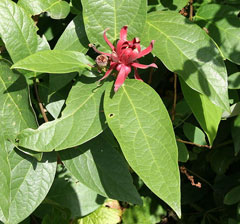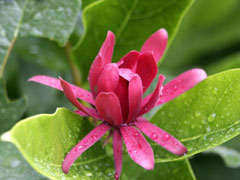 |
|
http://de.wikipedia.org/wiki/Benutzer:Michael_w |
 |
| http://www.flickr.com/people/12017190@N06 |
Translate this page:
Summary
Physical Characteristics

 Calycanthus occidentalis is a deciduous Shrub growing to 3 m (9ft) by 3 m (9ft).
Calycanthus occidentalis is a deciduous Shrub growing to 3 m (9ft) by 3 m (9ft).
See above for USDA hardiness. It is hardy to UK zone 7. It is in flower from June to September, and the seeds ripen from October to November. The species is hermaphrodite (has both male and female organs) and is pollinated by Insects.
Suitable for: light (sandy) and medium (loamy) soils and prefers well-drained soil. Suitable pH: mildly acid, neutral and basic (mildly alkaline) soils. It can grow in semi-shade (light woodland) or no shade. It prefers moist soil.
UK Hardiness Map
US Hardiness Map
Synonyms
C. macrophyllus.
Plant Habitats
Woodland Garden Sunny Edge; Dappled Shade;
Edible Uses
Edible Parts:
Edible Uses: Condiment
The aromatic bark is dried and used as a substitute for cinnamon and all spice[11, 105]. Some caution is advised, see reports above on toxicity[270].
References More on Edible Uses
Medicinal Uses
Plants For A Future can not take any responsibility for any adverse effects from the use of plants. Always seek advice from a professional before using a plant medicinally.
Expectorant Stomachic
The bark is expectorant[257]. A decoction of the fresh or dried bark has been used in the treatment of sore throats, severe colds and stomach disorders[257].
References More on Medicinal Uses
The Bookshop: Edible Plant Books
Our Latest books on Perennial Plants For Food Forests and Permaculture Gardens in paperback or digital formats.

Edible Tropical Plants
Food Forest Plants for Hotter Conditions: 250+ Plants For Tropical Food Forests & Permaculture Gardens.
More

Edible Temperate Plants
Plants for Your Food Forest: 500 Plants for Temperate Food Forests & Permaculture Gardens.
More

More Books
PFAF have eight books available in paperback and digital formats. Browse the shop for more information.
Shop Now
Other Uses
Basketry Dye
A light brown dye is obtained from the flowers[168]. The wood and the bark from fresh shoots has been used in basket making[257].
Special Uses
Food Forest Scented Plants
References More on Other Uses
Cultivation details
Prefers a light loamy soil that is deep and moist but succeeds in most fertile soils if they are not shallow[11, 182]. Requires a well-drained soil[188]. Prefers a sunny position but it tolerates shade when grown in warm temperate zones[11, 200]. Requires a sheltered position, protected from cold winds[245]. Plants are hardy to about -15°c[184]. The leaves and the flowers are very aromatic according to one report[188], whilst another says that the leaves and wood are pleasantly aromatic, whilst the flowers have no scent[245]. Plants in this genus are notably resistant to honey fungus[200].
References Carbon Farming Information and Carbon Sequestration Information
Temperature Converter
Type a value in the Celsius field to convert the value to Fahrenheit:
Fahrenheit:
The PFAF Bookshop
Plants For A Future have a number of books available in paperback and digital form. Book titles include Edible Plants, Edible Perennials, Edible Trees,Edible Shrubs, Woodland Gardening, and Temperate Food Forest Plants. Our new book is Food Forest Plants For Hotter Conditions (Tropical and Sub-Tropical).
Shop Now
Plant Propagation
Seed - best sown in a cold frame as soon as it is ripe. If the seed is harvested 'green' (as soon as it has fully developed but before it has dried on the plant) and sown immediately it can germinate in 3 weeks[113]. Dried seed germinates in 1 - 6 months at 15°c[138]. Stored seed requires between 3 weeks and 3 months cold stratification before sowing in the spring. When large enough to handle, prick out the seedlings into individual pots and grow them on in the greenhouse for their first winter. Plant out in late spring or early summer of the following year. Cuttings of half-ripe wood, July/August in a frame. They can be difficult[113]. Layering in spring. Sever the new plants in a wet spell of weather about 15 months later and then lift them in the autumn[78]. High percentage[78]. Division of suckers in early spring[11]. Very easy, they can be planted straight out into their permanent positions if required.
Other Names
If available other names are mentioned here
Native Range
NORTHERN AMERICA: United States (Washington (west), California (north & central))
Weed Potential
Right plant wrong place. We are currently updating this section.
Please note that a plant may be invasive in one area but may not in your area so it's worth checking.
Conservation Status
IUCN Red List of Threatened Plants Status :

Growth: S = slow M = medium F = fast. Soil: L = light (sandy) M = medium H = heavy (clay). pH: A = acid N = neutral B = basic (alkaline). Shade: F = full shade S = semi-shade N = no shade. Moisture: D = dry M = Moist We = wet Wa = water.
Now available:
Food Forest Plants for Mediterranean Conditions
350+ Perennial Plants For Mediterranean and Drier Food Forests and Permaculture Gardens.
[Paperback and eBook]
This is the third in Plants For A Future's series of plant guides for food forests tailored to
specific climate zones. Following volumes on temperate and tropical ecosystems, this book focuses
on species suited to Mediterranean conditions—regions with hot, dry summers and cool, wet winters,
often facing the added challenge of climate change.
Read More
Expert comment
Author
Hook.&Arn.
Botanical References
11200270
Links / References
For a list of references used on this page please go here
Readers comment
| Add a comment |
|
If you have important information about this plant that may help other users please add a comment or link below. Only comments or links that are felt to be directly relevant to a plant will be included. If you think a comment/link or information contained on this page is inaccurate or misleading we would welcome your feedback at [email protected]. If you have questions about a plant please use the Forum on this website as we do not have the resources to answer questions ourselves.
* Please note: the comments by website users are not necessarily those held by PFAF and may give misleading or inaccurate information.
To leave a comment please Register or login here All comments need to be approved so will not appear immediately.
|
Subject : Calycanthus occidentalis
|
|
|
|